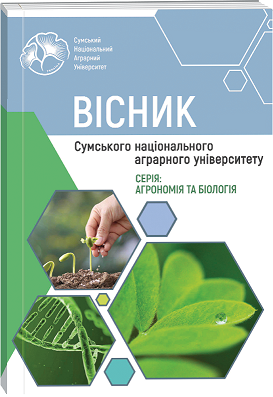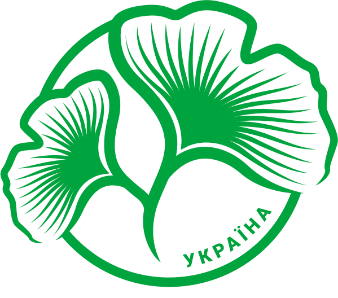SPECIES COMPOSITION, POPULATION DYNAMICS, AND SEX RATIO OF SCALE INSECTS AND FALSE SCALES IN FRUIT ORCHARDS OF THE RIGHT-BANK FOREST-STEPPE OF UKRAINE
Abstract
The study presents findings on the species composition of armored scales (Diaspididae) and soft scales (Coccidae), identifying dominant species and evaluating their distribution dynamics across various fruit orchards. The analysis also considered the sex ratio and fluctuations in the proportion of infertile females. The research was conducted following established methodologies (Stankevych et al., 2022; Frewin et al., 2019; Deligeorgidis et al., 2008) during 2023–2024 in the experimental orchards of the Uman National University of Horticulture. The study encompassed the following fruit varieties: apple (Jonagold, Idared, Renet Simirenko, Golden Delicious), sweet cherry (Dar Mliyeva, Melitopol Spotted, Drogana Yellow), plum (Hanita, Italian Prune), and pear (Zolotovorotska, Clapp’s Favorite). For each variety, five model trees were selected for sample collection. Within the fruit orchard ecosystems, four phytophagous species from the superfamily Coccoidea were identified, three belonging to the family Diaspididae and one to the family Coccidae. The California red scale (Aonidiella aurantii) was the most prevalent species across the years of study and among all fruit crops. Its relative abundance ranged from 87.5% in apple orchards to 56.2% in cherry orchards. The sex ratio within the California red scale population demonstrated dependence on both the generational stage and the host plant species. A decline in population density correlated with a reduction in the proportion of males in successive generations across all host plants. The highest male-to-female ratio was observed on apple trees, while the lowest ratio and overall population density were recorded in cherry orchards. A direct relationship was established between the proportion of infertile females and the female-to-male ratio, reflected in the sex index. When the ratio was 1 male to 1–8 females, the proportion of infertile females remained low, ranging from 1% to 3%. However, as the female-to-male ratio increased to 9–12 females per male, the proportion of infertile females increased significantly, up to 11%, representing a nearly 3.5-fold rise. Further increases in the female-to-male ratio led to a progressive growth in the number of infertile females, emphasizing the impact of sex ratio dynamics on reproductive success within the population.
References
2. Anton T. Yu., Pospielova H. D., & Nechyporenko N. I. (2021). Otsinka prynadlyvosti sortiv yabluni dlia kaliforniiskoi shchytivky [Assessment of the susceptibility of apple varieties to California scab]. Suchasni aspekty i tekhnolohii u zakhysti roslyn : materialy Mizhnarodnoi nauk. – prakt. internet-konf. (m. Poltava, 26 lystopada 2021 r.). PDAA, Poltava, 10–13 (in Ukrainian).
3. Buzzetti, К., Chorbadjian, R., & Nauen, R. (2015). Resistance Management for San Jose Scale (Hemiptera: Diaspididae). Econ Entomol Dec;108(6), 43–52. doi: 10.1093/jee/tov236
4. Buzzetti, K., Chorbadjian, R., Fuentes-Contreras, E., Gutiérrez, M., Ríos, J., & Nauen, R. (2016). Monitoring and mechanisms of organophosphate resistance in San Jose scale, Diaspidiotus perniciosus (Hemiptera: Diaspididae). Journal of Applied Entomology, 140(7), 507–516.
5. Chernii, A M. Rehuliatory zhyttiediialnosti komakh (2008). [Regulators of life activity of insects]. Kyiv : Koloobih, 296 (in Ukrainian).
6. Deligeorgidis, N. P., Kayoglou, S., & Sidiropoulos, G. (2008). Monitoring and Control of Quadraspidiotus perniciosus (Comstock) Hemiptera: Diaspididae on Apple Trees in the Prefecture of Florina, Greece. Journal of Entomology, 5 (6), 381–388.
7. Frewin, A., Lopez, B., Cox, A., Hoffman, E., & Hazell, J. (2019). Comparison of two traps for monitoring California red scale (Hemiptera: Diaspididae). Fla Entomol, 102, 586–591. doi: 10.1653/024.102.0343
8. Golan, K. (2020). Contribution to the knowledge of the San José scale (Hemiptera, Coccomorpha, Diaspididae) in Poland. Polish J. Entomol, 89, 7–19. doi: 10.5604/01.3001.0014.0288
9. Golan, K., Kot, I., Kmieć, K., & Górska-Drabik, E. (2023) Approaches to integrated pest management in orchards: Comstockaspis perniciosa (Comstock) case study. Agriculture, 13(1), 131. doi: 10.3390/agriculture13010131
10. Gut, L., Irish-Brown, A., & Pochubay, E. (2019). Early Season Sprays for Managing San José Scale, Michigan State University, 45, 23–30.
11. Hopkinson, J., Balzer, J., Fang, C., & Walsh, T. (2023). Insecticide resistance management of Bemisia tabaci (Hemiptera: Aleyrodidae) in Australian cotton – pyriproxyfen, spirotetramat and buprofezin. Pest Manag Sci May; 79(5), 1829–1839. doi: 10.1002/ps.7361.
12. Hunchak, M. V. (2017). Fitosanitarnyi monitorynh yablunevykh nasadzhen v Pivdenno Zakhidnomu Lisostepu. [Phytosanitary monitoring of apple plantations in the Southwest Forest Steppe.] Zbirnyk naukovykh prats Natsionalnoho naukovoho tsentru “Instytut zemlerobstva NAAN“, 2, 115–125 (in Ukrainian).
13. Ianovskyi, Y. P. (2019). Dovidnyk iz zakhystu plodovykh kultur. [Handbook on the protection of fruit crops]. Phoenix, Kyiv, 472 (in Ukrainian).
14. Ianovskyi, Y. P. (2021). Prohrama zakhystu plodovykh kultur. [Program for the protection of fruit crops: a monograph]. Phoenix, Kyiv, 146 (in Ukrainian).
15. Insha, H. (2021). Incidence of San Jose Scale, (Quadraspidiotus perniciosus Comstock) in Relation to Abiotic Factors on Apple Tree. International Journal of Current Microbiology and Applied Sciences, 10 (01). doi: 10.20546/ijcmas.2021.1001.203
16. Jorgensen, C. D., Rice, R. E., Hoyt, S. C., & Westigard, P. H. (1981). Phenology of the San Jose scale (Homoptera: Diaspididae). Can. Entomol. 113, 149–159. doi: 10.4039/Ent113149-2
17. John, C., Wise, Celeste E., & Larry, J. (2018). Control of San Jose Scale in Sweet Cherry. Arthropod Management Tests, Section B: Stone Fruits 45(1), 1–1. doi:10.1093/amt/tsaa041
18. Khomenko, I. I. (1996). Zakhyst zerniatkovykh sadiv u Tsentralnomu Lisostepu Ukrainy. [Protection of seed orchards in the Central Forest-Steppe of Ukraine: a monograph]. Phoenix, Kyiv, 240 (in Ukrainian).
19. Korniienko, O. A. (2001). Parazyty i khyzhaky kaliforniiskoi shchytivky [Parasites and predators of the California scale]. Zakhyst Roslyn, 3, 27 (in Ukrainian).
20. Liakhovskyi, O. M., & Krykunov I. V. (2024) Vyvchennia biolohichnykh osoblyvostei kaliforniiskoi shchytivky (Quadraspidiotus perniciosus Comst.) v umovakh Pravoberezhnoho Lisostepu Ukrainy. [Study of biological characteristics of the san jose scale (Quadraspidiotus perniciosus Comst.) under the conditions of the right-bank Forest-Steppe region of Ukraine]. Visnyk Umanskoho natsionalnoho universytetu sadivnytstva 2, 40–43 (in Ukrainian). doi: 10.32782/2310-0478-2024-2-40-43
21. Mague, D. L. (1982). Biology of the San Jose scale (Quadraspidiotus perniciosus (Comstock» (Homoptcra: Diaspididae) in New York State apple orchards: male flight phenology and crawler dispersal. Ph.D. thesis, Cornell University, Ithaca, N.Y., 74
22. Mague, D., & Land Reissig, H. (1983). Phenology of the San Jose scale (Homoptera: Diaspididae) in New York State apple orchards. Can. Entomol., 115, 717–722. doi: 10.4039/ Ent115717-7.
23. Movchan, O. M. (2002). Karantynni shkidlyvi orhanizmy: pidruchnyk. [Quarantine harmful organisms: a textbook]. Kyiv, World, 1, 288 (in Ukrainian).
24. Muneer, A. (2023). Degree day-based management of San Jose scale (Quadraspidiotus perniciosus) by horticulture mineral oils (HMOS) at dormant stage in apple orchards of Kashmir. Journal of experimental zoology. INDIA, 5, 1400–1405. doi: 10.51470/jez.2023.26.2.1401
25. Muneer, A. (2023). Management of San Jose Scale (Quadraspidiotus perniciosus) by HMOs and Insecticides in Apple Orchards of Kashmir, India, International Journal of Plant & Soil Science, 35, (18), doi: 10.9734/IJPSS/2023/v35i183434
26. Rice, R. E., & Jones, R. A. (1988). Timing post-bloom spray for peach twig borer (Lepidoptera: Gelichiidae) and San Jose scale (Homoptera: Diaspididae). J. Econ. Entomol. 81, 293–299. doi: 10.1093/jee/81.1.293
27. Robayo, E., & Chong, J. H. (2015). General biology and current management approaches of soft scale pests (Hemiptera: Coccidae). J. Integ. Pest Mngmt. 6, 17–23. doi: 10.1093/jipm/pmv016
28. Sheidyк, K., & Salka, O. (2023). Monitorynh dominuiuchykh vydiv komakh-shkidnykiv i yikh shkodochynnist u sadakh riznoho tekhnolohichnoho zabezpechennia zony Zakarpattia [Monitoring of the dominant species of insect pests and their harmfulness in the gardens of various technological support of the Transcarpathian zone]. Naukovyi visnyk Uzhhorodskoho universytetu. Seriia Biolohiia, vypusk 54, 135–147 (in Ukrainian). doi: 10.32782/1998-6475.2023.54.
29. Stankevych, S. V., Lezhenina, I. P., & Zabrodina, I. V. (2022). Rehulovani nekarantynni shkidlyvi orhanizmy: navch. posib. [Regulated non-quarantine pests: a textbook]. Kharkiv. National Agrarian University named after V.V. Dokuchaeva Publishing House I. S. Ivanchenko, Kharkiv, 272 (in Ukrainian).
30. Stankevych, S. V., & Hornovska, S. V. (2022). Metody vyiavlennia, zboru ta zberihannia komakh: navchalnyi posibnyk [Methods of detecting, collecting and storing insects: a study guide]. Vydavnytstvo «Ruta», Zhytomyr, 140 (in Ukrainian)
31. Turenko, V. (2023). Zakhyst yablunevykh nasadzhen vid osnovnykh shkidnykiv [Protection of apple plantations from main pests] Scientific Progress & Innovations, 26 (4), 60–65 (in Ukrainian) doi: 10.31210/spi2023.26.04.11
32. Wearing, C. H., & Boer, J. A. (2014). Sampling of San José scale (Diaspidiotus perniciosus Hemiptera: Diaspididae) in an apple orchard. New Zealand Entomologist 37(2), 125–140. doi: 10.1080/00779962.2013.795646

 ISSN
ISSN  ISSN
ISSN 



